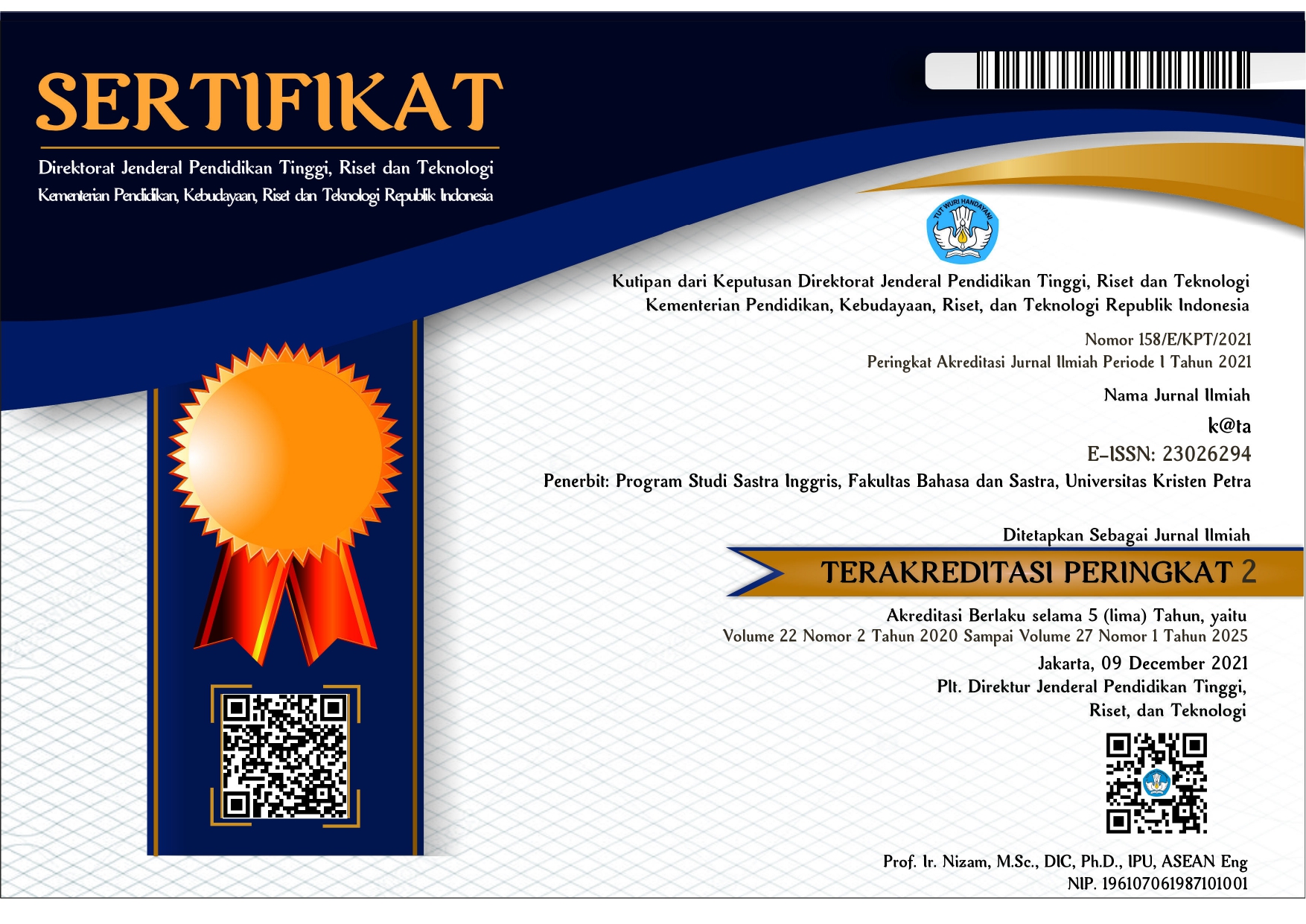Juncture Patterns of the Surabaya-citizen’s Speech
Keywords:
Pattern, juncture, Chinese language, sentence.
Abstract
In this paper, the researcher examines juncture patterns of Chinese language of Surabaya citizens who do not use Bahasa or Indonesian language as their mother tongue. The purpose is to see whether juncture patterns of local citizens can resemble the native speakers. The method that is used here is qualitative approach. The research on these juncture patterns is expected to contribute to the pattern map of the Surabaya citizen’s speech in order to develop the Phonology Theory of Juncture. Based on the analysis of ten respondents, producing nine declarative sentences, seven interrogative sentences, six imperative sentences, and four exclamatory sentences, juncture patterns happen sometimes after a subject, after a predicate, between two words, and sometimes between two syllables within a word. Juncture happens before a word when the word is emphasized. The second finding is that juncture between syllables in a word is not always shorter than the one that happens between two words. The last finding is that there are two kinds of juncture, stopping and continuing juncture.Downloads
Download data is not yet available.
References
Alwi, H., Dardjowidjojo, S., Lapoliwa, H., Moeliono, A.M. (2003). Tata Bahasa Baku Bahasa Indonesia (edisi ketiga). Jakarta: Balai Pustaka.
Chaer, A. (2007). Linguistik umum. Jakarta: Rineka Cipta.
Dörnyei, Z. (2007). Research methods in applied linguistics: Quantitative, qualitative, and mixed methodologies. New York: Oxford University Press.
Fáng, Y. (房玉清). (2008). ShÃyòng Hà nyÇ” yÇ”fÇŽ (实用汉è¯è¯æ³•). BÄ›ijÄ«ng: BÄ›ijÄ«ng YÇ”yán Dà xué ChÅ«bÇŽnshè.
Halliday, M.A.K., & Ruqaiya, H. (1976). Cohesion in English. London: Longman.
Hú, Y. (èƒ¡è£•æ ‘). (1993). Xià ndà i Hà nyÇ” (现代汉è¯). Hongkong: Joint Publishing Co., Ltd.
Hú, J. (胡å‰æˆ). (2006). Xià ndà i Hà nyÇ” jÄ«chÇ” (现代汉è¯åŸºç¡€). BÄ›ijÄ«ng: BÄ›ijÄ«ng Dà xué ChÅ«bÇŽnshè.
Huáng, B., & Lià o, X. (黄伯è£ã€å»–åºä¸œ). (2005). Xià ndà i Hà nyÇ” (现 代汉è¯). BÄ›ijÄ«ng: GÄodÄ›ng Jià oyù ChÅ«bÇŽnshè.
Leech, G. (2003). Semantik (P. Partana, Trans.). Yogyakarta: Pustaka Pelajar Offset.
Liú, Y. (刘月åŽ), PÄn, W. (潘文娱), & Gù, W. (故韡). (2001). ShÃyòng xià ndà i Hà nyÇ” yÇ”fÇŽ (实用现代汉è¯è¯æ³•). BÄ›ijÄ«ng: ShÄngwù YìnshÅ«guÇŽn.
Miles, M. B., & Huberman, A. M. (1992). Analisis data kualitatif. Jakarta: Universitas Indonesia.
Marsono. (2006). Fonetik. Yogyakarta: Gadjah Mada University Press.
Samarin,W. J. (1988). Field linguistics: A guide to linguistic field. (J.S. Badudu, Trans.). Yogyakarta: Kanisius.
Wú, J. (å´æ´æ•). (2000). Hà nyÇ” jiélÇœxué (汉è¯èŠ‚律å¦). BÄ›ijÄ«ng: YÇ”wén ChÅ«bÇŽnshè.
XÃng, F. (é‚¢ç¦ä¹‰), & Wà ng, G. (汪国胜). (2009). Xià ndà i Hà nyÇ” (现代汉è¯). Wúhà n: HuázhÅng ShÄ«fà n Dà xué ChÅ«bÇŽnshè.
XÃng, F. (é‚¢ç¦ä¹‰). (2001). Xià ndà i Hà nyÇ” (现代汉è¯). BÄ›ijÄ«ng: GÄodÄ›ng Jià oyu ChÅ«bÇŽnshè.
XÃng, G. (邢公畹). (2003). Xià ndà i Hà nyÇ” jià ochéng (现代汉è¯æ•™ç¨‹). TiÄnjÄ«ng: NánkÄi Dà xué ChÅ«bÇŽnshè.
Yè, F. & Xú, T. (å¶èœšå£°ã€å¾é€šé”µ). (1997). YÇ”yánxué gÄngyà o (è¯è¨€å¦çº²è¦). BÄ›ijÄ«ng: BÄ›ijÄ«ng Dà xué ChÅ«bÇŽnshè.
Chaer, A. (2007). Linguistik umum. Jakarta: Rineka Cipta.
Dörnyei, Z. (2007). Research methods in applied linguistics: Quantitative, qualitative, and mixed methodologies. New York: Oxford University Press.
Fáng, Y. (房玉清). (2008). ShÃyòng Hà nyÇ” yÇ”fÇŽ (实用汉è¯è¯æ³•). BÄ›ijÄ«ng: BÄ›ijÄ«ng YÇ”yán Dà xué ChÅ«bÇŽnshè.
Halliday, M.A.K., & Ruqaiya, H. (1976). Cohesion in English. London: Longman.
Hú, Y. (èƒ¡è£•æ ‘). (1993). Xià ndà i Hà nyÇ” (现代汉è¯). Hongkong: Joint Publishing Co., Ltd.
Hú, J. (胡å‰æˆ). (2006). Xià ndà i Hà nyÇ” jÄ«chÇ” (现代汉è¯åŸºç¡€). BÄ›ijÄ«ng: BÄ›ijÄ«ng Dà xué ChÅ«bÇŽnshè.
Huáng, B., & Lià o, X. (黄伯è£ã€å»–åºä¸œ). (2005). Xià ndà i Hà nyÇ” (现 代汉è¯). BÄ›ijÄ«ng: GÄodÄ›ng Jià oyù ChÅ«bÇŽnshè.
Leech, G. (2003). Semantik (P. Partana, Trans.). Yogyakarta: Pustaka Pelajar Offset.
Liú, Y. (刘月åŽ), PÄn, W. (潘文娱), & Gù, W. (故韡). (2001). ShÃyòng xià ndà i Hà nyÇ” yÇ”fÇŽ (实用现代汉è¯è¯æ³•). BÄ›ijÄ«ng: ShÄngwù YìnshÅ«guÇŽn.
Miles, M. B., & Huberman, A. M. (1992). Analisis data kualitatif. Jakarta: Universitas Indonesia.
Marsono. (2006). Fonetik. Yogyakarta: Gadjah Mada University Press.
Samarin,W. J. (1988). Field linguistics: A guide to linguistic field. (J.S. Badudu, Trans.). Yogyakarta: Kanisius.
Wú, J. (å´æ´æ•). (2000). Hà nyÇ” jiélÇœxué (汉è¯èŠ‚律å¦). BÄ›ijÄ«ng: YÇ”wén ChÅ«bÇŽnshè.
XÃng, F. (é‚¢ç¦ä¹‰), & Wà ng, G. (汪国胜). (2009). Xià ndà i Hà nyÇ” (现代汉è¯). Wúhà n: HuázhÅng ShÄ«fà n Dà xué ChÅ«bÇŽnshè.
XÃng, F. (é‚¢ç¦ä¹‰). (2001). Xià ndà i Hà nyÇ” (现代汉è¯). BÄ›ijÄ«ng: GÄodÄ›ng Jià oyu ChÅ«bÇŽnshè.
XÃng, G. (邢公畹). (2003). Xià ndà i Hà nyÇ” jià ochéng (现代汉è¯æ•™ç¨‹). TiÄnjÄ«ng: NánkÄi Dà xué ChÅ«bÇŽnshè.
Yè, F. & Xú, T. (å¶èœšå£°ã€å¾é€šé”µ). (1997). YÇ”yánxué gÄngyà o (è¯è¨€å¦çº²è¦). BÄ›ijÄ«ng: BÄ›ijÄ«ng Dà xué ChÅ«bÇŽnshè.
Published
2012-11-01
How to Cite
O.M.F., K. (2012). Juncture Patterns of the Surabaya-citizen’s Speech. K@ta: A Biannual Publication on the Study of Languange and Literature, 14(1), 23-30. https://doi.org/https://doi.org/10.9744/kata.14.1.23-30
Section
Articles
![]() This work is licensed under a Creative Commons Attribution License
This work is licensed under a Creative Commons Attribution License



.png)
.png)

.png)













